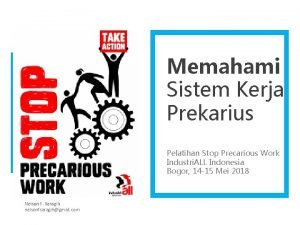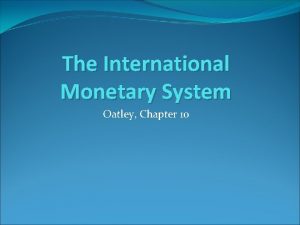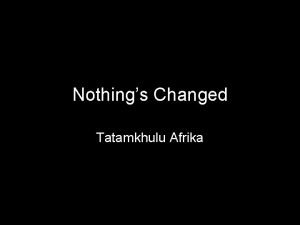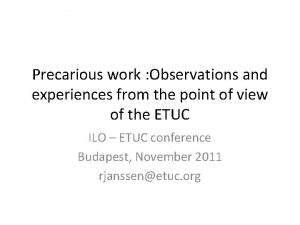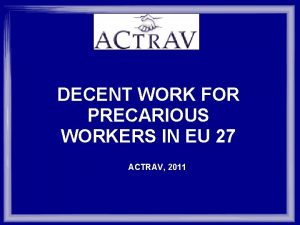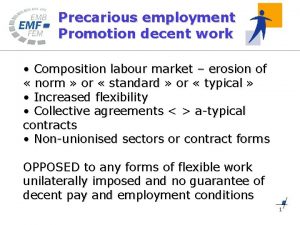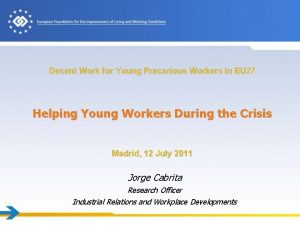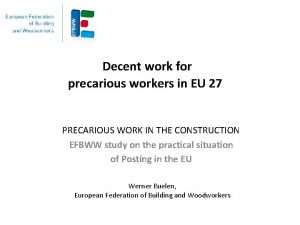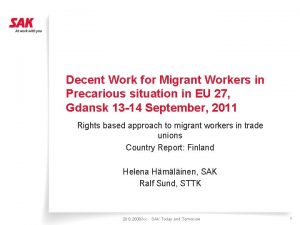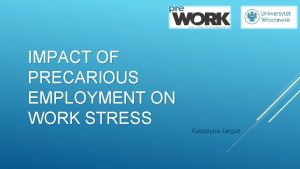How Precarious Work Has Changed Perceptions and Understandings




















- Slides: 20

How Precarious Work Has Changed Perceptions and Understandings of Labour Law Prof. César F. Rosado Marzán, Ph. D, JD Presentation for Conference: New Foundations of Labour Law in the Globalised Market Economy? Stockholm, Thursday 19 May – Friday 20 May 2016

What is “precarious”? • Webster’s Dictionary: – depending on the will or pleasure of another – dependent on uncertain premises – dependent on chance circumstances, unknown conditions, or uncertain developments – characterized by a lack of security or stability that threatens with danger

What is “precarious”? • Oxford Dictionary • 1. Esp. of a right, tenancy, etc. : – held or enjoyed by the favour of and at the pleasure of another person; – vulnerable to the will or decision of others….

What is “precarious”? • b. Dependent on chance or circumstance; uncertain; liable to fail; exposed to risk, hazardous; insecure, unstable.

What is “precarious”? • C. Subject to or fraught with physical danger or insecurity; at risk of falling, collapse, or similar accident; unsound, unsafe, rickety.

Precarious work Is: • “Employment that is uncertain, unpredictable and risky from the point of view of the worker. ” • (Kalleberg 2009)

ILO • Half of all global work is wage and salaried. • 45% of those are fulltime and permanent, and decreasing. • Only 1 in 4 working people in standard employment.

Evidence of precariousness Decline in attachment to employers Increase in long-term unemployment Growth in perceived job insecurity Growth in nonstandard work arrangements and contingent work, or “fissuring” • Increase in risk-shifting from employers to workers. • • Adapted from Kalleberg 2009: 6 -8, and Weil (2015)

Polanyi’s Double-Movement: Flexibility and Security Source: Kelleberg 2009

Responses in

Responses • “Flexicurity” – Generous income security – Active labor market – Continutiing vocational training

Responses • Increase the minimum wage (Fight for $15) • “Fair scheduling” • Expand joint-employer liabilities • Limit independent contracting • Affordable Care Act (Obama Care)

Responses • “Feeling the Bern” – Invest over US $ 1 trillion for direct job creation and training – Free public universities – Medicare for all (universal health care)

Responses • Minimum wage law • Intermediate “employee-like” category • Collective bargaining: – Qualification – Demography – Operate in new framework – Decentralization and derogations

France • Groupement d’employeurs. • Proposals to – flex hiring and firing – Enable derogation of some legal minima through collective bargaining and – Or even unilaterally by employers

France • Argument in favor of proposals: Will create incentives to increase regular employment, which is too risky and costly under current law (for employers)

Global Supply Chains • 20% of workers work in global supply chain. • More productive. • Earn as much as those not in chain. • Competition and short cycle impact contractual arrangements. Source: ILO (2015)

Global Supply Chains • ILO (2015): – Social dialogue – Active labor market policies (to offset losses in jobs) – Labor regulation and enforcement at bottom. – Fundamental rights ensured in entire chain.

Perceptions and Understandings of Labour Law: Some Conclusions • “Labour law” cannot do it alone. Should be complemented by: – “Social security” law; – Direct government employment; – “Active labor market” and publicly provided education; • Collective bargaining must be aided by direct government standards (minimum wages);

Perceptions and Understandings of Labour Law: Some Conclusions • Labor standards must cover workers in intermediate categories, but not necessarily all protections (Davidov 2005). • Labour law is the problem (? ) • Transnational dimension: Apply those lessons also to global chains.
 Precarious work
Precarious work Precarious in a sentence
Precarious in a sentence What is an enduring understanding
What is an enduring understanding Year 11
Year 11 Enduring understanding examples
Enduring understanding examples Drugs that alter moods, thoughts, and sense perceptions
Drugs that alter moods, thoughts, and sense perceptions Drugs that alter moods thoughts and sense perceptions
Drugs that alter moods thoughts and sense perceptions Psychedelic drugs that distort perceptions and evoke
Psychedelic drugs that distort perceptions and evoke A chemical substance that alters perception and mood
A chemical substance that alters perception and mood American imperialism political cartoon analysis
American imperialism political cartoon analysis How did you respond to the ending of the metamorphosis
How did you respond to the ending of the metamorphosis What does the first apparition tell macbeth
What does the first apparition tell macbeth How has technology changed sports
How has technology changed sports How has technology changed our perception
How has technology changed our perception Has the exchange rate changed chapter 10
Has the exchange rate changed chapter 10 Has the exchange rate changed chapter 10
Has the exchange rate changed chapter 10 Trustyourperceptions
Trustyourperceptions Rocks changed by temperature pressure and hot liquids
Rocks changed by temperature pressure and hot liquids Chapter 4 section 1 work and machines answer key
Chapter 4 section 1 work and machines answer key Change the world unit10
Change the world unit10 When was nothing's changed written
When was nothing's changed written
